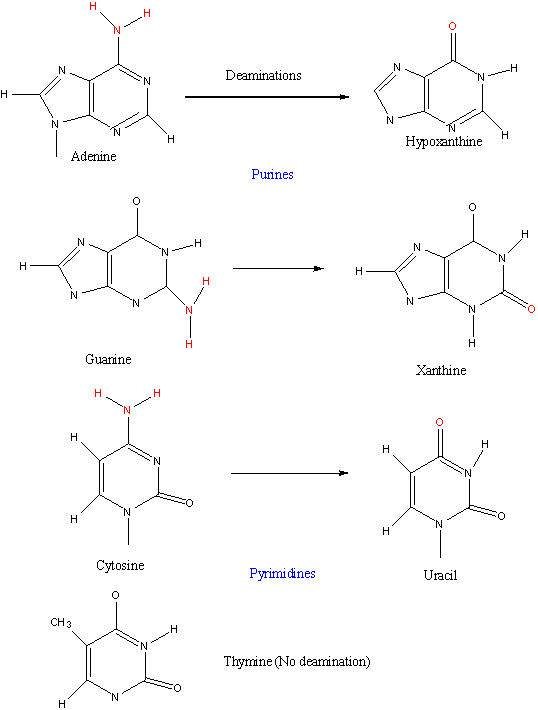Maintaining genetic stability requires not only accurate ways to replicate DNA but also mechanisms to repair damage that occurs to DNA. The importance of such repair mechanisms is illustrated by the diseases which result when such mechanisms do not work. A few examples include:
-
a defect in something called the ATM protein, which is a protein kinase activated by double strand breaks results in the disease ataxia-telangiectascia (AT) whose symptoms include neurodegeration and a predisposition to .
-
A defect in some of the proteins used in such as results in colon cancer.
-
A defect in repair by results in the syndrome BRCA-2 whose phenotype includes breast and ovarian cancer.
-
A defect in accessory results in Werner syndrome whose phenotype is premature aging.
-
A defect in results in zeroderma pigmentosum whose phenotype is skin cancer and UV sensitivity.
DNA is susceptible to spontaneous changes such as the following:
-
Depurination where purine bases (Adenine and guanine) are lost.
-
Deamination of C to U or the deamination of A to hypoxanthine or guanine to xanthine.

-
Thymine dimers which is the covalent linage between 2 adjacent pyrimidine bases (C or T).
Two main method of DNA repair involve excising the damaged DNA and then restoring the original DNA sequence by a DNA polymerase that uses the undamaged strand as a template. In the first method, base excision repair, enzymes called DNA glycosylases each of which can recognize specific types of altered base catalyze its hydrolytic removal. For example, a deaminated C can be removed by a uracil DNA glycosylase. It is believed that the glycosylase flips from base to base along the helix and once it recognizes a damaged base, it creates a deoxyribose sugar that lacks its base. This hole created by the glycosylase is called an “AP site” because it is either apurinic (devoid of A or G) or apyrimidinic (devoid of C or T). Another enzyme AP endnuclease then comes along and removes the sugar phosphate.
In the second method, nucleotide excision repair bulky lesions such as the various pyrimidine dimers caused by sunlight can be repaired. In this process, a large multienzyme complex scans DNA for distortion in the double helix rather than for a specific base. Once found, the phosphodiester backbone of the abnormal strand is cleaved on both sides and the large gap produced in the helix is repaired by DNA polymerase and DNA ligase. A defect in the nucleotide excision repair process can result in xeroderma pigmentosum (SP)whose symptoms include skin caner and cellular UV sensitivity.
Two different methods are used to repair double strand DNA breaks which are caused by things like radiation. The first method, nonhomologous end joining simply juxtaposes the broken ends and rejoins them by DNA ligation. The second method, homologous end-joining requires special recombination proteins which recognize areas of DNA sequence matching between two chromosomes and brings them together.

